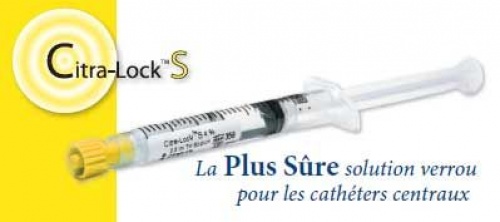Lock solution Citralock
Lock solution for dialysis catheter
Citra-Lock™ - catheter lock solution, anti-clotting and antimicrobial is one of the innovations from Dirinco.
Anti-biofilm
Citrate binds to calcium:
It is known that the construction of the biofilm is dependent on Calcium and Magnesium. Citra-LockTM is a strong chelator of both Mg2+ and Ca2+ leading to a decreased biofilm formation in catheters filled with Citra-LockTM and in this way preventing the catheter of related infections.
Anti-coagulant
Citra-lock™ causes anticoagulation by chelation of ionised calcium in the extracorpereal circuit into a soluble complex. Because calcium is an integralion involved in the clotting cascade, local removal by Citra-Lock™ prevents the activation of clotting factors, factor X, and prothrombin, and the ultimate formation of fibrin. Systematic anticoagulation does not occur.
1. Ash SR (2000) Concentrated Sodium Citrate (23%) for Catheter Lock. Haemodialysis International 4:22-31
Anti microbial
Citra-Lock™ the Safe and Superior catheter lock solution.
The greatest significant decrease in incidence of symptomatic bacteraemia appears
to occur with the use of 47% Citra-Lock1.
It prevents formation of biofilm in the catheter lumen, by eliminating the growth of
bacteria, yeast and fungi which would normally form the biofilm.
1. Ash SR (2000) Concentrated Sodium Citrate (23%) for Catheter Lock. Haemodialysis International 4:22-31
Superior Antimicrobial Activity of Citra-Lock™ over Heparin
On all microbial strains heparin didn't show any inhibitory effect at all. Citra-Lock™ 30% and Citra-Lock™ 46,7% demonstrated an inhibitory effect on all the strains. Both concentrations of Citra-Lock also inhibit growth of C. albicans.
Agar diffusion susceptibility test. BA plates seeded with S. Aureus and wells filled with heparin (left), Citra-LockTM 30% ( middle) and Citra-Lock™ 46,7% ( right) after 24 hours at 37ºC showing large zone of bacterial killing for the citrate solutions.
2. VU Amsterdam(2005), Agar diffusion usceptibility test for heparine, Cita-Lock™ 30% and Citra-Lock™ 46,7%, Microbiological lab VU Amsterdam
- Caracteristics
- Detail
- Related products
| Reference | Designation |
| Citralock 4 | Citra-Lock™ 4% Needle Free Vial 5ml |
| Citralock 30 | Citra-Lock™ 30% Needle Free Vial 5ml |
| Citralock 46,7 | Citra-Lock™ 46,7% Needle Free Vial 5ml |
| Citralock-S 4 | Citra-Lock™S 4% 2.5 ml sterile pre-filled syringe |
| Citralock-S 30 | Citra-Lock™S 30% 2.5 ml sterile pre-filled syringe |
| Citralock-S 46,7 | Citra-Lock™S 46,7% 2.5 ml sterile pre-filled syringe |
Increase Safety & Simplicity
The new Citra-Lock™ vials: Drip free and with Luer connector
-
preventing microbial contamination
-
protecting against needle stick injuries
-
reducing handling steps
-
promoting intuitive handling
Bibliographies
Lok CE, Appleton D, Bhola C, Khoo B, Richardson RM. Trisodium citrate 4%-an alternative to heparin capping of haemodialysis catheter. Nephrol Dial Transplant. 2006 Oct.
Grudzinski L et al. Sodium Citrate 4% locking solution for central veinous dialysis catheters – an effective, more cost efficient alternative to heparin. NDT Advance Access published October 25, 2006 Nephrol. Dial. Transplant doi:10/1093/ndt/gfl606.
Lok CE, Appleton D, Bhola C, Richardson RMA, et al. Trisodium citrate 4% : A less costly yet effective alternative to heparin capping of haemodialysis catheters. J.Am.Soc.Nephrol(Nov) 16:452A 2005
Michaud D, Komant T, Pfefferle P. Four percent trisodium citrate as an alternative anticoagulant for maintaining patency of central venous hemodialysis catheters : case, report and discussion. Am J Crit Care 2001;10:351-354
Buturovic J, Ponikvar R, Kandus A, Boh M, Klinkmann J, Ivanovich. Filling hemodialysis catheters in the interdialytic period : heparin vs citrate versus polygeline : a prospective randomized study. Artiff Organs 1998;22:945-947
Bayes B, Bonal J, Romero R. Sodium citrate for filling haemodialysis catheters. Nephrol Dial Transplant 1999; 14:2532-2533
Hendrickx L, Kuypers D, Evenepoel P, Maes B, Messiaen T, Vanrenterghem Y. A comparative prospective study on the use of low concentrate citrate lock versus heparin lock in permanent dialysis catheter. Int J Artif Organs 2001; 24:208-211
Flanigan MJ, Pillsbury L, Saderwasser G, Lim VS. Regional hemodialysis anticoagulant : Hypertonic tri-sodium citrate or anticoagulant citrate dextrose-A. Am J Kidney Dis 1996; 27:519-524
Meeus G, Kuypers DR, Claes K, Evenepoel P, Maes B, Vanrenterghem Y. A prospective, randomized, double-blind crossover study on the use of 5% citrate lock versus 10% citrate lock in permanent hemodialysis catheters. Blood Purif 2005;23:101-105.
Food and Drug Administration. FDA issues warning on Tricitrasol dialysis catheter anticoagulant. FDA. http://www.fda.gov/bbs/topics/answers/ANS01009.html.2001.
Humber River Regional Hospital retrospective analysis to evaluate clinical experience with the use of sodium citrate 4% versus heparin 10,000 u/ml to maintain long term interdialytic patency of central venous hemodialysis catheter. (available upon request)
Citra-Valve
Bidirectionnal valve
Citra-Valve
Bidirectionnal high pressure valve
- Less handling
- Easy connection to the CVC
- Prevention against the CVC infections
- Time consuming
- Safe
Cutting-edge device to fight against CVC infection
- Easy connection to the extension lines
- Less manipulation on the hub of the extension lines
- Easy luer lock connection
- Caracteristics
- Detail
- Related products
Reference
Citra-Valve™ : 24060995 (90 x 2 valves per boxes)
Composition
- Corps – Polycarbonate
- Valve - Silicone


